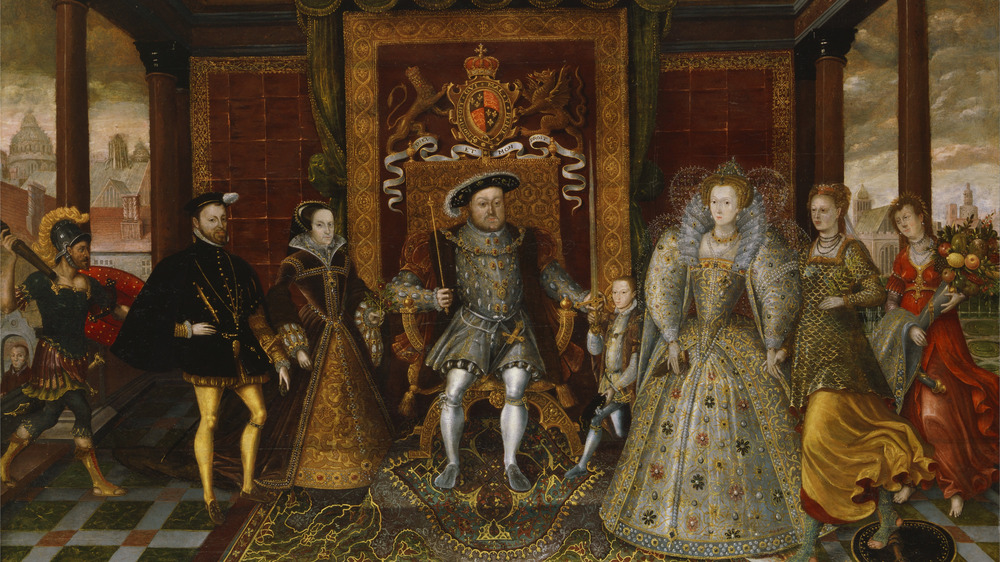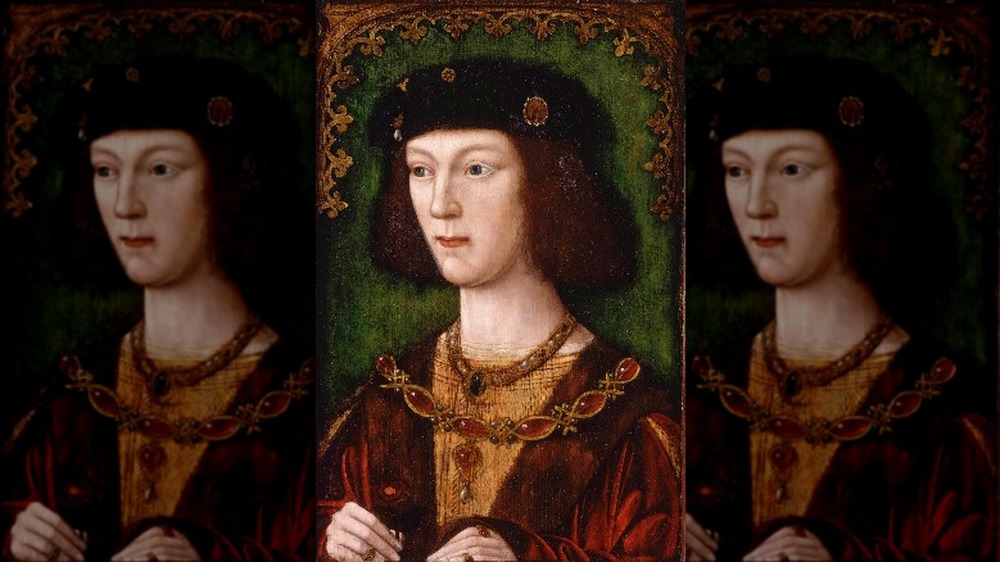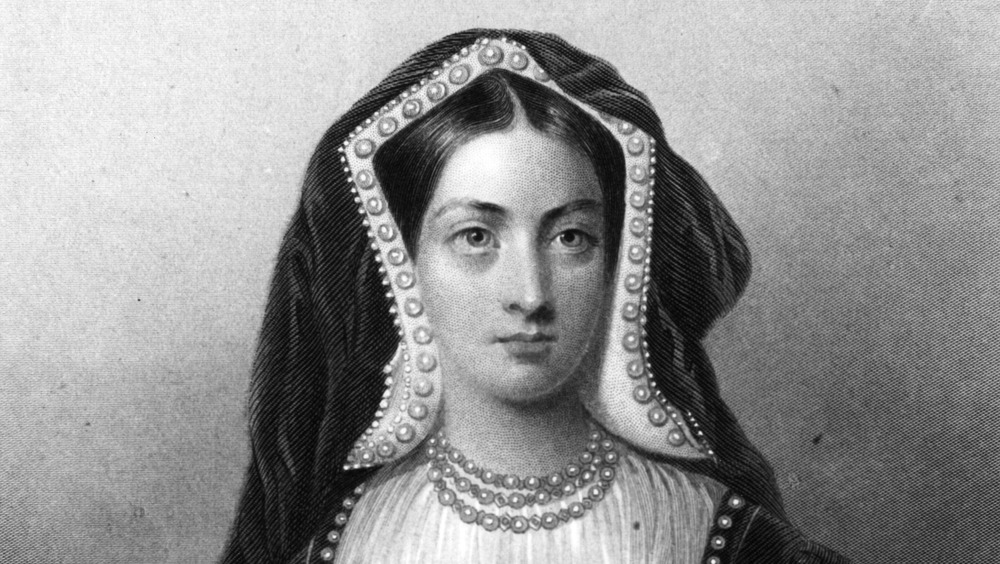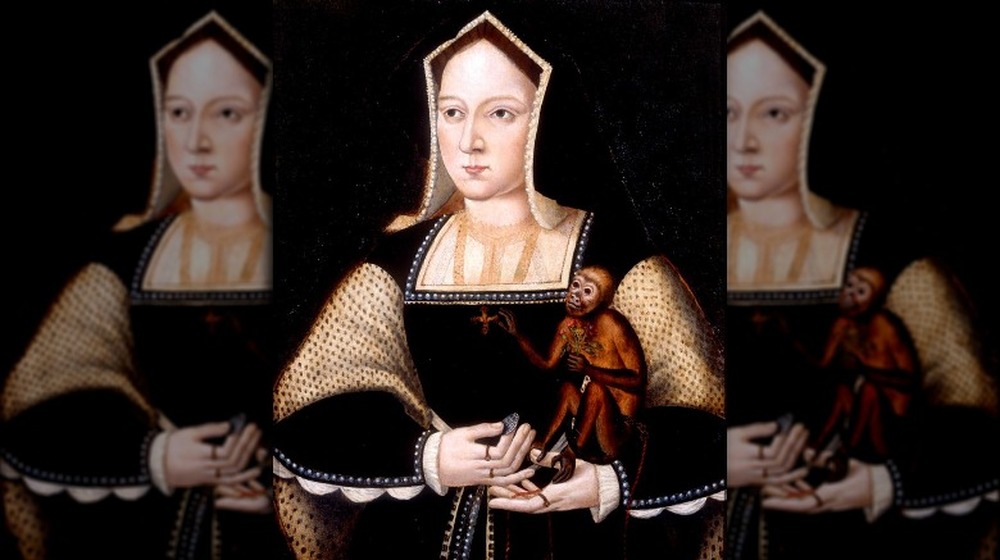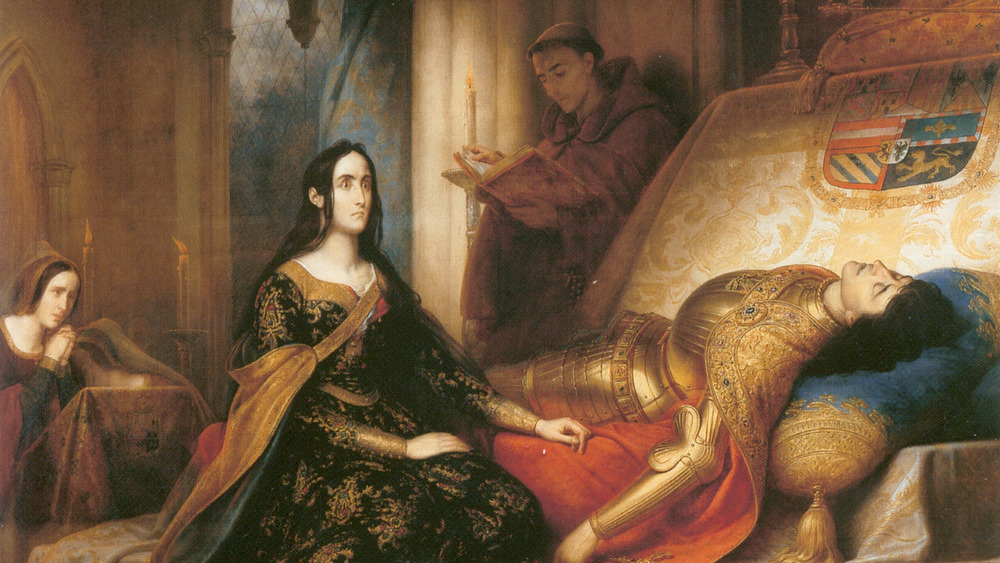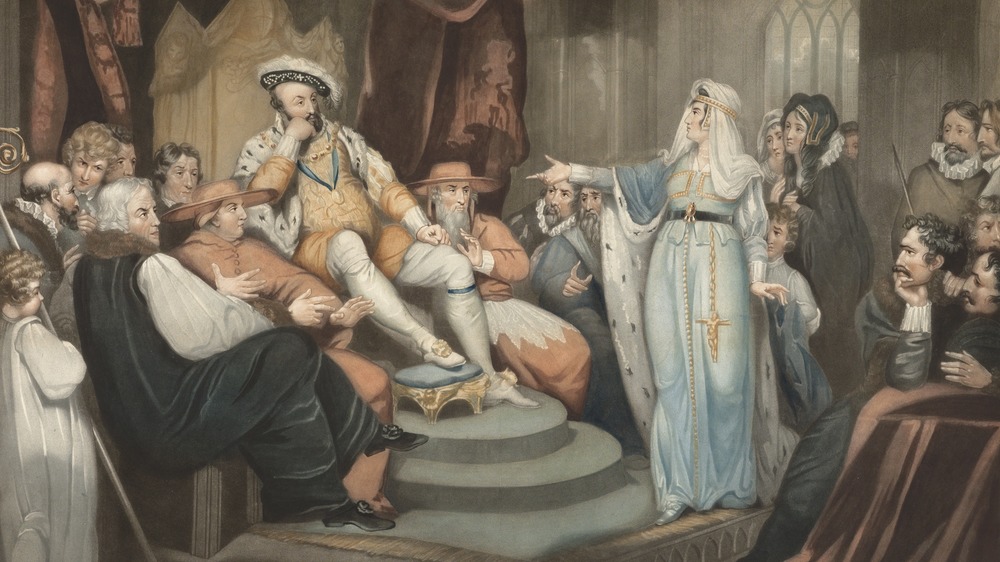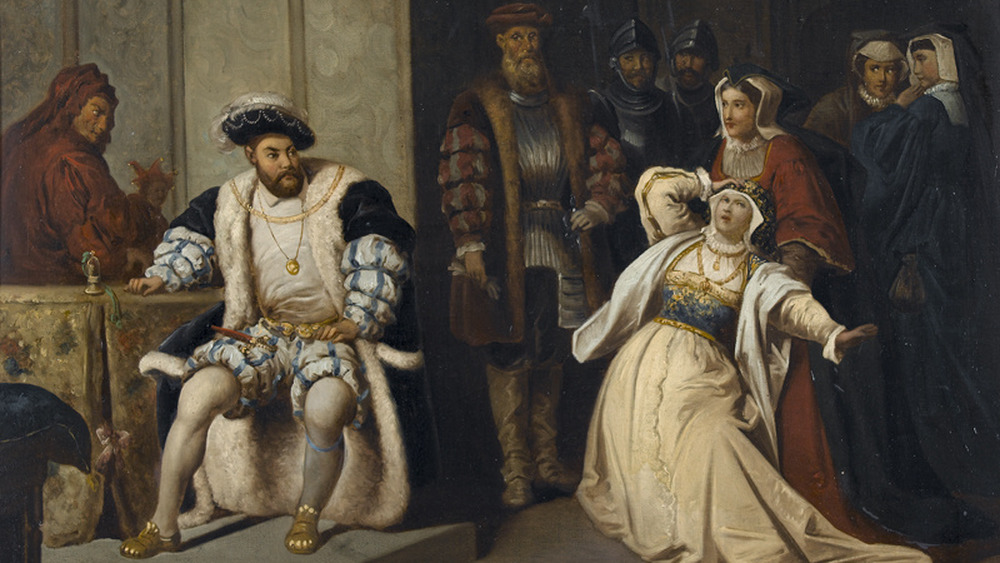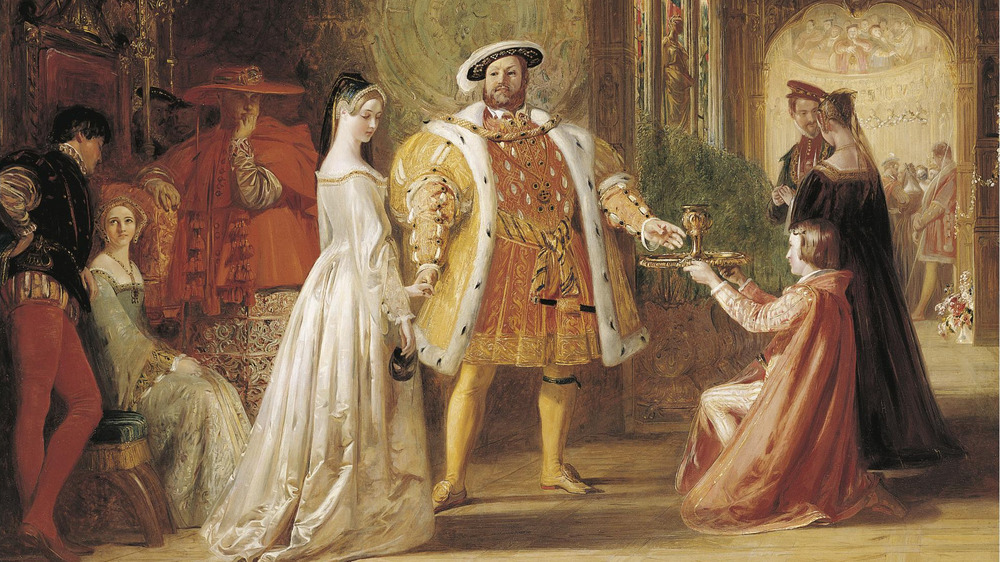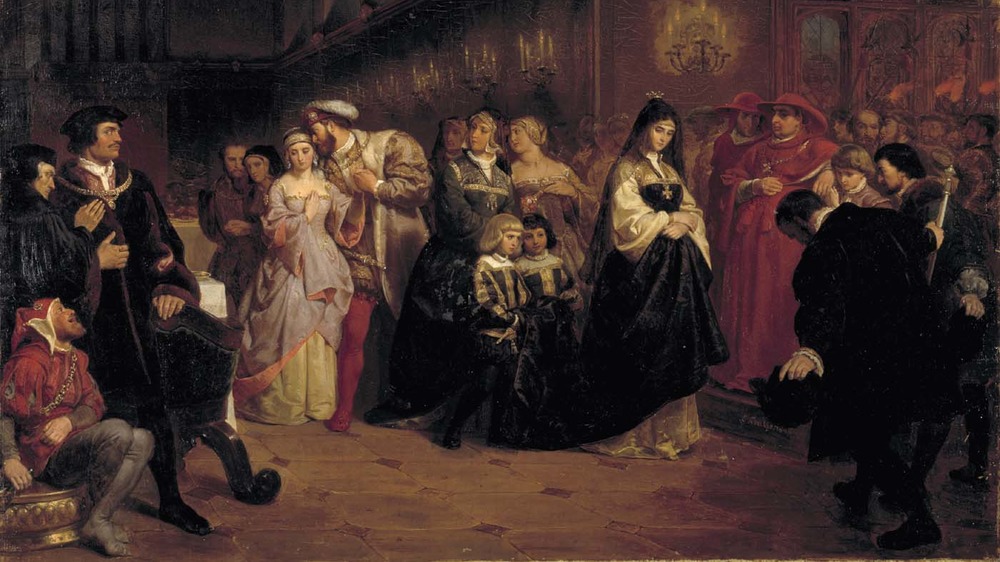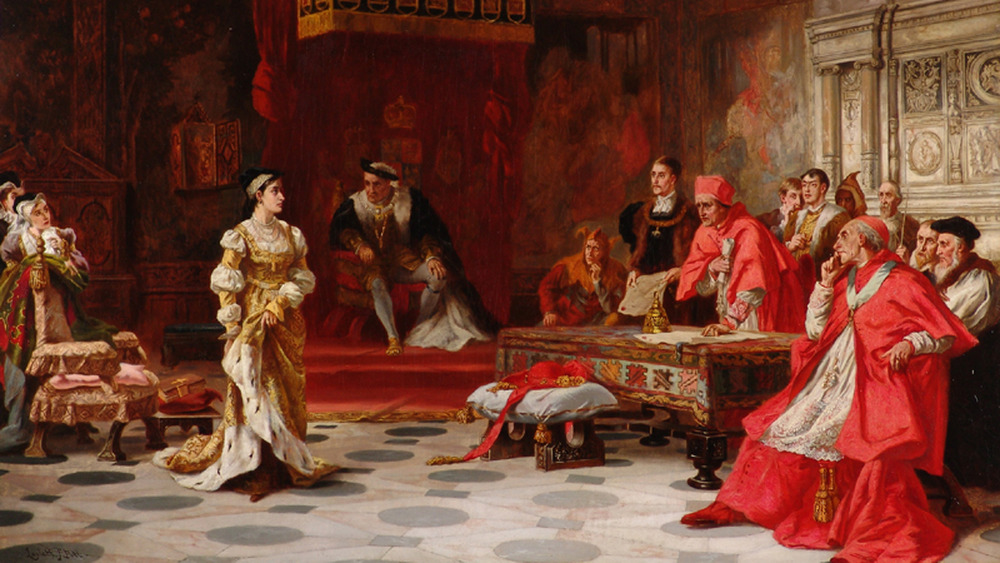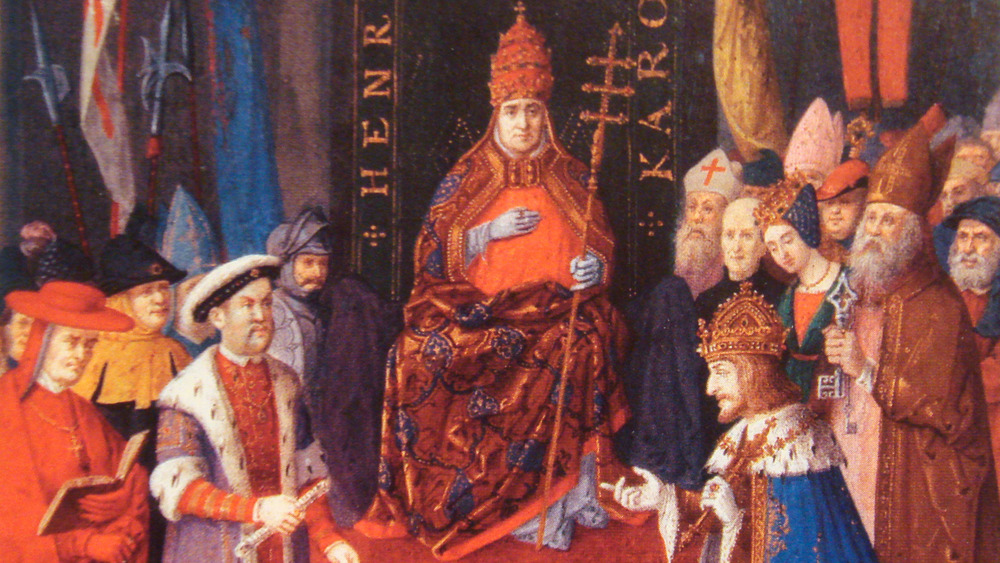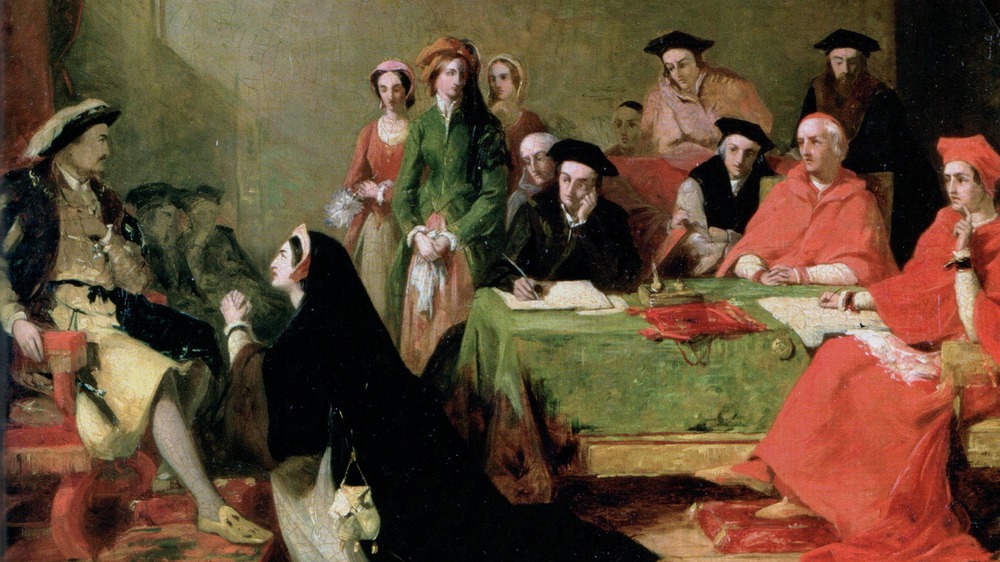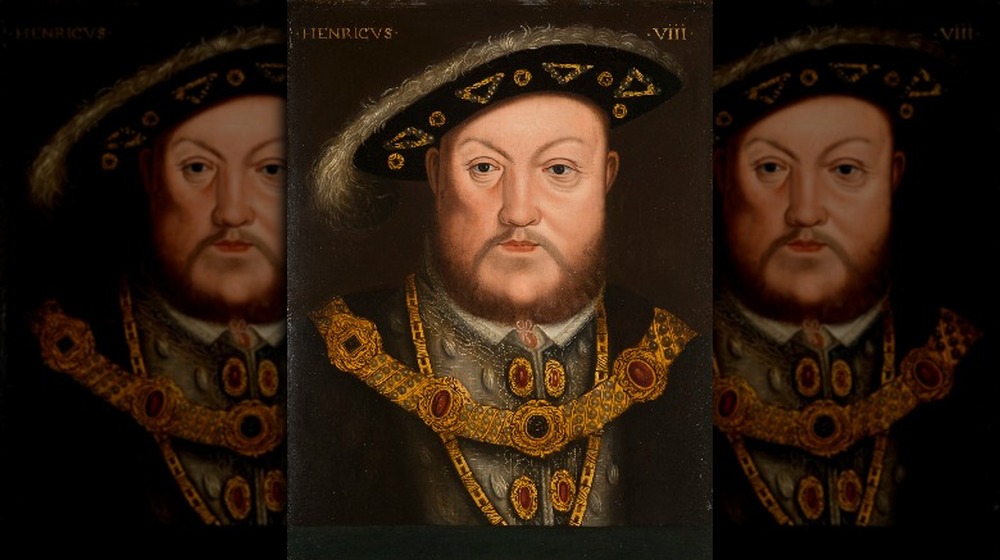The Real Reason Henry VIII Couldn't Get A Divorce
Henry VIII is probably the most famous king of England of all time, thanks in large part to the notoriety of his long string of wives. Henry tried and failed with wife after wife to produce a male heir that could succeed him to the throne, but the first couple couldn't managed to give him a son. While this process eventually got to be old hat, there was quite a scandal surrounding Henry's first wife, Catherine of Aragon, a Spanish princess to whom he was married for 24 years. The dissolution of their relationship also brought about a revolution within the church and changed history forever.
But why was a revolution (and multiple executions) necessary? Was the church so strict that even a king couldn't get a divorce? Well, yes and no. It turns out that there were a number of complicating factors. Read on to find out why Henry and Catherine couldn't just break up.
Henry wasn't even supposed to be king
Considering that Henry VIII is arguably the most famous king in English history, it might surprise you that he was never meant to be king. He was the second son of Henry VII and so was not the primary heir to the throne of England. As History explains, Henry's older brother Arthur was the one who was being prepared for the throne, while it was assumed that Henry might join the church, a common destiny for second sons in that time. As a result, Henry was given an education in theology and the arts rather than statecraft. Britannica says that Henry excelled in both academics and athletics and had a "willful, ebullient character." Meanwhile, his brother Arthur was engaged at the age of two to Catherine of Aragon, the daughter of the Spanish king and queen Ferdinand and Isabella, whom you may remember from the Christopher Columbus story. Arthur and Catherine, while still teenagers, were married in 1501.
Then less than a year later, Arthur died of a sudden and unexplained illness. This made the 10-year-old Henry the new heir, and as a result, all of Arthur's former responsibilities were thrust upon him. This included Arthur's politically motivated marriage to Catherine, which had ended tragically early. In 1503, a pre-teen Henry VIII found himself engaged to be married to his dead older brother's teenage widow.
Permission from the pope to marry your sister
As ThoughtCo explains, Henry VIII was originally supposed to marry Eleanor of Austria, but when his brother Arthur died, everything changed. Arthur's marriage to Catherine of Aragon was supposed to solidify an alliance between England and Spain, and Arthur's death jeopardized that. As a result, Henry was engaged to his brother's widow. This, however, presented a problem, religiously speaking. The Catholic Church has rules regarding consanguinity–that is, how closely related to a person you're allowed to be if you want to marry them. In this case, the church regarded Henry and Catherine as brother and sister (since she had married his brother, two become one, you get it), which is definitely way too close for consanguinity laws.
Furthermore, the Book of Leviticus chapter 20 says, "If a man takes his brother's wife, it is impurity; he has uncovered his brother's nakedness; they shall be childless." All of this made the Henry-Catherine pairing a sticky wicket, so to speak. However, it was entirely possible to get the pope to grant a special dispensation to allow the marriage despite the rules, which is extra possible if you're the king. The pope granted the dispensation, but Catherine argued with a clause in the paperwork that assumed she and Arthur had consummated their marriage, which she claimed they had not. Nevertheless, Henry VII wanted to cover all the bases, and so the consummation clause remained.
Delaying the marriage of Henry and Catherine of Aragon
Henry VIII and Catherine of Aragon were formally engaged on June 25, 1503, when Henry was just shy of 12-years-old and Catherine was 17. As ThoughtCo explains, the reasons for the delay between Arthur's death and Henry and Catherine's betrothal wasn't merely the wait for the papal dispensation that would allow young Henry to marry his brother's widow, which would not arrive until 1505. There was also the issue of Catherine's dowry: even though Catherine and Arthur had gotten married, that wedding had taken place without Spain having paid the entirety of Catherine's dowry to England. Henry VII demanded that Ferdinand and Isabella pay the balance of Catherine's dowry before allowing the betrothal with the younger Henry to take place. After months of squabbling and political maneuvering and bluffing, the monarchs finally came to a consensus and a treaty was drawn up allowing for the betrothal of the prince and the teen widow.
Prince Henry and Catherine did not live together after their betrothal, largely due to Henry's young age. The betrothal agreement said that the two would be married after Henry turned 15 and Catherine's parents paid the rest of her dowry. In the meantime, Catherine lived apart from the royal court, together with a mostly Spanish household, and had barely learned to speak any English, despite having already been married to Arthur.
A succession crisis in Castile
In the time it took for the papal dispensation for Henry VIII and Catherine of Aragon's marriage to arrive from Rome, a crisis had arisen in Catherine's homeland of Spain. As ThoughtCo explains, Queen Isabella of Castile died in 1504 with no male heirs, leading to something of a succession crisis. See, Spain wasn't really one country then. Isabella had named her husband, Ferdinand, the king of Aragon, as the ruler of Castile in her will, but instead, Catherine's sister Joanna and her husband Archduke Philip were named heirs to the kingdom of Castile. Ferdinand disputed this claim, but Henry VII backed Philip, and Ferdinand relented. However, Philip soon died and Joanna–known as Juana the Mad–was deemed unfit to rule for reasons of mental illness, and so her father Ferdinand ended up serving as regent of Castile until Joanna's son was old enough to assume the throne.
All of this instability in Spain meant that Henry VII's alliance with them was not as valuable as it once was, making Prince Henry's still-forthcoming marriage to Catherine less alluring than it had been. Still awaiting a dowry payment, Henry VII reduced his financial support of Catherine and her household and planned to end her betrothal to Prince Henry. Catherine's fate was unclear for years until her father named her the ambassador to England, allowing her to stay in England despite the status of her betrothal.
Henry VIII and Catherine of Aragon finally marry
Even though Henry VIII and Catherine of Aragon were officially betrothed in 1503, a number of issues had delayed their getting married: Henry's young age, the dispute over Catherine's dowry, the succession crisis in Castile, waiting for the papal dispensation to arrive, and Henry VII's growing ambivalence toward his alliance with Spain, among other things. However, everything changed in 1509 when Henry VII died. As The Anne Boleyn Files explains, Prince Henry became King Henry VIII at the age of 17. He announced that he wanted to marry Catherine as quickly as possible, as it had been his father's dying wish that the two should finally marry. This was almost certainly untrue, as Henry VII had long soured on the idea of this marriage, but it was also known that Henry VIII felt guilty about marrying his brother's widow and had in fact formally repudiated the proposed match as soon as he was old enough, so who knows why he would lie about it.
Anyway, Henry and Catherine were married a few weeks later in a quiet ceremony at Greenwich Palace. The marriage negotiations had taken nearly seven years, but the marriage was finalized on June 11, 1509. The wedding was closely followed by a joint coronation ceremony, which would have been unusual at the time, as normally a queen would not be crowned until after the birth of the first heir.
Heir today, gone tomorrow
Henry VIII and Catherine of Aragon were married when he was not quite 18 and she was 23. The two of them were in their physical primes and were both known for their good looks and virtue. As ThoughtCo explains, Catherine was involved in the politics of England in her first year as queen, helping to navigate the increasingly unsteady alliance between England and Spain, ultimately choosing her husband over her father, however.
By most accounts, Henry and Catherine were very happy together, but a king cannot be truly happy until he has an heir. Their first hope was a daughter that was miscarried in 1510. The following year Catherine gave birth to a boy, Henry, who was named Prince of Wales, but who died at only a few weeks old. By 1513, Catherine was pregnant again and was named Queen Regent while Henry went off to fight France for a few months, and she managed to successfully fight off an invasion from Scotland. She did not, however, successfully deliver an heir, as she miscarried again in 1513 and in the next year gave birth to a stillborn son.
All of this stress and tragedy put incredible tension on Henry and Catherine's once-happy marriage. Catherine at last gave birth to a living heir, a daughter, Mary, in 1515, but after another stillborn child in 1518 would never become pregnant again.
Henry VIII's many mistresses
While Henry and Catherine's relationship is believed to have been unusually good despite the stress brought on by the substantial loss they experienced while trying to have children, it is nevertheless known that Henry had numerous affairs. Just how many is not known, and not all of those that have been claimed can be substantiated. Nevertheless, Tudors Dynasty gives a thorough overview of Henry's potential mistresses, including Anne Hastings, the sister of the Duke of Buckingham, and Etiennette de la Baume, a Flemish woman that Henry encountered while fighting the French.
There are only two women about whom there is no dispute that Henry engaged in affairs with them. The first of these was Bessie Blount, one of Catherine's maids-of-honor (this means she was a junior attendant to the queen, not that she was in her wedding party). Henry's affair with her lasted several years, as opposed to most of his affairs, which were generally short-lived. The affair ended when Bessie became pregnant with Henry's son, whom the king lovingly acknowledged and who was named Henry FitzRoy ("son of the king"). King Henry named FitzRoy the Duke of Richmond and kept him as a sort of backup plan if Catherine never gave him a son. The other undisputed mistress is Mary Boleyn, one of Catherine's ladies-in-waiting, about which relationship we know very little except that she had a sister that Henry liked better.
The King's Great Matter
Catherine of Aragon's continued inability to produce a male heir for Henry eventually reached a crisis point, leading to what became known at court as the king's "Great Matter." As Britannica explains, Catherine was seven years older than Henry and no longer capable of bearing children. The king's options were fairly limited: he could legitimize Henry FitzRoy and name him heir; he could marry his daughter Mary to FitzRoy (or someone else) and hope they had a grandson for him before he died; or he could annul his marriage to Catherine and marry someone who could give him a son. Henry knew that basing his plans around an illegitimate son were dicey, as FitzRoy's inheritance of the throne would be easily challenged. Even if Henry planned to name FitzRoy his successor, a claim backed up by a decent amount of evidence, this issue was compounded by the fact that FitzRoy died of tuberculosis in 1536, a decade before his father.
And so it seemed his third option was the best: end his marriage to Catherine and marry someone else. That intended someone else would turn out to be Anne Boleyn, the sister of Henry's mistress Mary Boleyn, with whom Henry began flirting sometime around 1526. Anne, a lady-in-waiting to Catherine of Aragon, refused Henry's advances, not wanting to become the king's mistress as her sister had. At this point, though, Henry didn't want to make her his mistress.
Henry VIII appeals to the church
There are two important things to keep in mind when thinking about Henry VIII's divorce from Catherine of Aragon and his ultimate separation from the Catholic Church: a) Henry didn't want a divorce at all, he wanted an annulment, and b) he didn't want to split from the Church, because he was a good Catholic boy.
As ThoughtCo explains, the difference between an annulment and a divorce is that an annulment says that a valid marriage never existed in the first place. Henry argued based on the Book of Leviticus that by marrying his brother's widow at his father's insistence, he had taken part in an invalid marriage and the curse of childlessness promised in the Bible on such a marriage had been carried out on him and Catherine.
Henry therefore appealed to the pope that his marriage might be annulled so that he would be allowed to remarry–specifically asking that he could marry someone that was related to someone else he'd had relations with (i.e., Anne Boleyn, sister of his former mistress). Henry wanted to follow the rules; he had a few years before been granted the title Defender of the Faith for denouncing the Protestant Reformation. Catherine, meanwhile, countered that she was the legitimate queen because she had never consummated her marriage to Henry's brother, meaning Henry's concerns of consanguinity were unfounded.
A hostage situation in Rome complicates matters
According to History, normally it wouldn't be a problem for a king to receive an annulment of marriage from the pope. Generally speaking, popes wanted to remain on kings' good sides, and there was an understanding on both sides that the continuation of a ruler's dynasty was of chief importance. But Henry faced two problems that made his case different from other royal petitions of the Supreme Pontiff. Firstly, his marriage to Catherine had only been made possible in the first place by a special dispensation from the pope. For Henry to ask a later pope to issue a dispensation counteracting the earlier one was basically asking one pope to say an earlier pope had been wrong, which is supremely uncool.
The other, arguably more important issue was that Catherine of Aragon's nephew was basically holding the current pope hostage. While it's really tempting to say that the issue of Henry's divorce was a great theological issue, the fact is, nah, Catherine's family took the pope prisoner and told him not to. The same year that Henry petitioned Rome for an annulment, Catherine's nephew Charles V, the Holy Roman Emperor, had attacked and destroyed Rome. Charles didn't want his aunt to be embarrassed and so used his newfound control of Rome to pressure the pope. The pope, however, knew Henry's request was reasonable and stalled for years.
Chancellors fall like dominoes
As ThoughtCo explains, by 1529, Pope Clement was no longer Charles V's prisoner, but Rome was still under the control of the Holy Roman Empire. The pope sent an envoy, Lorenzo Campeggi, to try to mediate a solution that would upset neither Henry nor Charles. While both Henry and Catherine made their appeals in Campeggi's court at first, soon Catherine stopped appearing at the hearings, and ultimately the court adjourned without stating a verdict and never reconvened. This meant that Henry's hopes of an annulment were basically done for, and he wasn't pleased with that one bit. Henry's representative in his negotiations with the pope had been his chancellor, Cardinal Wolsey, who negotiated through years of the pope's hemming and hawing. Henry removed Wolsey from his position as chancellor and charged him with treason. Wolsey, however, died before his trial could begin.
Henry replaced Wolsey as chancellor with not a clergyman, but a lawyer, Thomas More, the guy who invented the word "utopia." If you've read or seen the play A Man for All Seasons, you know that things don't go well for More, either. More, a devout Catholic, refused to take an oath to support Henry's divorce and marriage to Anne Boleyn. Like Wolsey before him, he was charged with treason, but he lived long enough to be executed. The Catholic Church named him a saint for his loyalty to the faith.
If at first you don't succeed, appoint yourself head of your own church
With the traditional channels shut off to him, Henry VIII needed to take action if he was going to be able to end his marriage to Catherine. He had failed to gain the support he wanted from Cardinal Wolsey and Thomas More, but as Britannica explains, he found it in the form of his new chief minister, Thomas Cromwell, and the new archbishop of Canterbury, Thomas Cranmer. These two Toms had strong Protestant leanings, and their advice ultimately led to Henry breaking with the Catholic Church and naming himself the Supreme Head of the Church of England. It was not how he wanted to do it, but Henry got what he wanted. In January 1533, Henry married Anne Boleyn. In May, Archbishop Cranmer declared Henry's marriage to Catherine annulled, thus making Mary an illegitimate heir. In September, Anne gave birth to a daughter, Elizabeth. The pope excommunicated Henry, but Henry didn't really care.
You probably don't need to be told that Henry's marriage to Anne Boleyn didn't work out, either. She also failed to produce a male heir and she was executed on charges of treasonous adultery. There were some other marriages afterwards that you might have also heard of. As ThoughtCo explains, when Henry was trying to invalidate his marriage to Anne, he accepted the validity of his marriage to Catherine and restored Mary as his heir.
